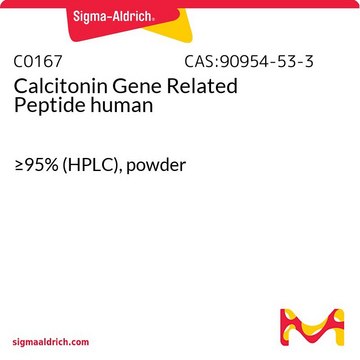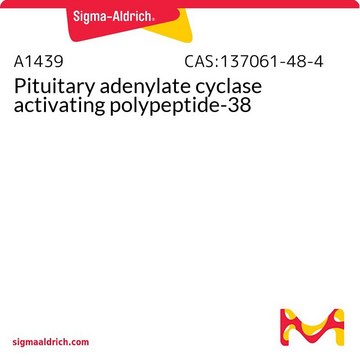C0292
Calcitonin Gene Related Peptide rat
≥95% (HPLC), powder
Sinónimos:
α-CGRP, CGRP-I
About This Item
Productos recomendados
origen biológico
rat
Nivel de calidad
Ensayo
≥95% (HPLC)
Formulario
powder
mol peso
3803.25-3809.25 Da
técnicas
cell based assay: suitable
nota de secuencia
Ser-Cys-Asn-Thr-Ala-Thr-Cys-Val-Thr-His-Arg-Leu-Ala-Gly-Leu-Leu-Ser-Arg-Ser-Gly-Gly-Val-Val-Lys-Asp-Asn-Phe-Val-Pro-Thr-Asn-Val-Gly-Ser-Glu-Ala-Phe-NH2
temp. de almacenamiento
−20°C
Información sobre el gen
rat ... Calca(24241)
¿Está buscando productos similares? Visita Guía de comparación de productos
Amino Acid Sequence
Descripción general
Calcitonin gene related peptide (CGRP) is a 37 amino acid neuropeptide. It exists in two isoforms α-CGRP and β-CGRP. CGRP is produced by the alternative splicing of the calcitonin gene (CALCA). They are primarily localized in the C and Aδ sensory fibers, but are also present in non-neuronal tissues, like the cardiovascular system.
Aplicación
- To study its protective role in lipopolysaccharide (LPS)-induced acute lung injury (ALI).
- To examine the effects of calcitonin gene related peptide (CGRP) and salmon calcitonin (sCT) on gastric lesions and mucosal barrier in stress induced rats.
- To mediate the complement component 5a (C5a) induced mechanical hypersensitivity by activating nerve fibers and influencing non-neuronal cell movement through its receptor.
Acciones bioquímicas o fisiológicas
Otras notas
Código de clase de almacenamiento
13 - Non Combustible Solids
Clase de riesgo para el agua (WGK)
WGK 3
Punto de inflamabilidad (°F)
Not applicable
Punto de inflamabilidad (°C)
Not applicable
Equipo de protección personal
Eyeshields, Gloves, type N95 (US)
Elija entre una de las versiones más recientes:
¿Ya tiene este producto?
Encuentre la documentación para los productos que ha comprado recientemente en la Biblioteca de documentos.
Los clientes también vieron
Nuestro equipo de científicos tiene experiencia en todas las áreas de investigación: Ciencias de la vida, Ciencia de los materiales, Síntesis química, Cromatografía, Analítica y muchas otras.
Póngase en contacto con el Servicio técnico









